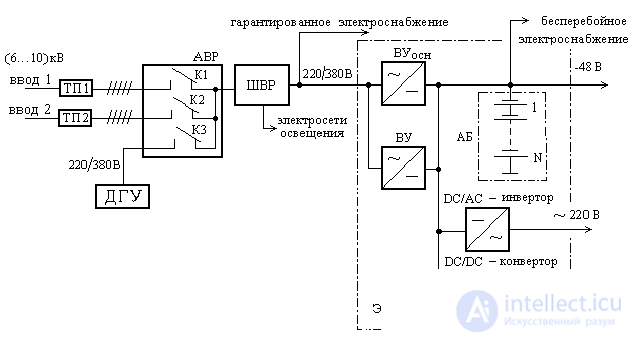Lecture
The power supply (power supply) circuit is responsible for the conversion of the electrical energy parameters of the primary source. The power supply circuit (power supply) is a set of devices designed to stabilize, regulate, distribute, backup, monitor and protect voltages and currents that ensure the normal operation of radio electronic devices. Without a power supply (power supply) circuit, operation of any power consumption *** devices and systems is impossible.
The power supply of electronic equipment substantially depends on its complexity, size, and current consumption. In the simplest devices for their power is enough to connect the battery or battery. In more complex power stabilizers will be required for individual chips. In radio electronic devices occupying a whole room or a room this is no longer enough. Regardless of the complexity of the device, all of them consume electricity and are called power consumers.
According to the degree of reliability of power supply, all electrical receivers are divided into three categories. Cellular and mobile communication systems belong to the consumers of a special group of the first category and their power supply should be provided from three independent sources. Two external inputs from two independent power lines (PTL), and the third from a backup power generator. A generalized block diagram of the power supply of electronic equipment (REA) is shown in Figure 1.

In Figure 1 there are: TP1 and TP2 - transformer substations, AVR - automatic input reserve, DGI - standby electric generator, ShVR - input distribution cabinet AC, AB - battery, VU - rectifier (main and backup), inverters and converters convert the main supply voltage (-24V or -48V) to the voltages required by concrete blocks and microcircuits.
The engine-generator set (DGS) backup generator is an internal combustion engine and a synchronous generator, mounted on a common frame as a single unit. Diesel is more economical than a gasoline engine, it has a longer service life, but is heavier at start-up. From a cold state, the diesel engine starts 10 ... 15 minutes. If you maintain a certain temperature of oil and coolant, then the duration of the starting mode is reduced to 20 ... 30 seconds. DGUs typically operate in automatic mode without the intervention of personnel (Pout = 1 ... 2000 kW, Uout = 230V ± 2%, f = 50Hz ± 1%).
When starting the backup generator, the voltage may drop for up to 30 seconds. In most cases, this is unacceptable. In this case, a battery is placed at the output of the rectifier, which, when the network is lost (emergency operation), provides the load with electricity. This is the so-called uninterrupted power supply buffer system. But there are other uninterruptible power supply schemes that have been actively developed in recent years and have been distinguished into a separate class of devices called uninterruptible power supply devices (UPS).
It should be noted that radio-electronic equipment does not always occupy the entire building. Most often it is a separate room in the building to which all communications have already been connected. In this case, it is not possible to be powered from several independent power lines and the power supply circuit is forcedly simplified. from the backup power supply remains only the gas generator. A similar power supply circuit of the electronic equipment is shown in Figure 2.

This method of providing guaranteed power is also not without flaws. It can be used in industrial buildings, where exhaust ventilation is provided or in sparsely populated areas, for example, to power electronic equipment of cell towers or radio relay communication lines. In the event that cellular transceivers are located on the roof of residential premises, the use of a generator as a backup power source becomes problematic.
Given that modern electronic equipment is usually low power ***, to ensure uninterrupted power in most cases, the use of a battery (AB) is sufficient. The structural diagram of such uninterrupted power supply is shown in Figure 3.

Servicing large capacity batteries is quite a challenge. In addition, during the operation of batteries, a couple of acids and alkalis are released. Therefore, the creation of batteries that do not require maintenance, has recently been given great attention. Currently, specialized uninterruptible power supplies have been developed, which contain sealed batteries and DC-to-AC converters. The block diagram of uninterruptible power supplies is shown in Figure 4.

Thus, the power supply unit diagram is designed to ensure uninterrupted power supply of electronic equipment.
Literature:
Comments
To leave a comment
Power supplies for electronic equipment
Terms: Power supplies for electronic equipment